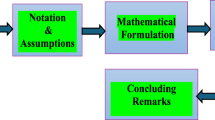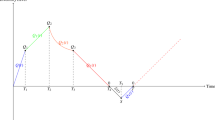Abstract
In developing the best strategy for real-world applications, the vendor must have some knowledge of the buyers’ behavior such as response to shortages and price increases. Using this knowledge, he can develop a policy that will ensure the largest net profit. Considering the fact, a two-warehousing inventory model has been developed where the demand is price-sensitive under the bulk release rule. Stockouts are allowed and are fully backlogged. Moreover, the transportation cost is taken to be dependent on the transported units. The model jointly optimizes the selling price and the order quantity by maximizing the system profit. Results have been validated with the help of a numerical example.
Similar content being viewed by others
References
Aggarwal SP, Jaggi CK (1989) Ordering policy for decaying inventory. Int J Syst Sci 20:151–155
Benkherouf L (1997) A deterministic order level inventory model for deteriorating items with two storage facilities. Int J Prod Econ 48:167–175
Bhunia AK, Maiti M (1998) A two-warehouse inventory model for deteriorating items with a linear trend in demand and shortages. J Oper Res Soc 49:287–292
Eliashberg J, Steinberg R (1991) Marketing-production joint decision making. In: Eliashberg J, Lilien JD (eds) Management science in marketing. Handbooks in operations research and management science. Elsevier, Amsterdam
Cohen MA (1977) Joint pricing and ordering policy for exponentially decay inventory with know demand. Nav Res Logist Q 24:257–268
Gallego G, Ryzin GV (1994) Optimal dynamic pricing of inventories with stochastic demand over finite horizon. Manag Sci 40:999–1020
Goswami A, Chaudhuri KS (1992) An economic order quantity model for items with two levels of storage for a linear trend in demand. J Oper Res Soc 43:157–167
Hartely VR (1976) Operations research—a managerial emphasis. Good Year, Santa Monica, pp 315–317 (chap 12)
Kar S, Bhunia AK, Maiti M (2001) Deterministic inventory model with two levels of storage, a linear trend in demand and a fixed time horizon. Comput Oper Res 28:1315–1331
Mukhopadhyay S, Mukherjee RN, Chaudhuri KS (2004) Joint pricing and ordering policy for a deteriorating inventory. Comput Ind Eng 47:339–349
Mukhopadhyay S, Mukherjee RN, Chaudhuri KS (2005) An EOQ model with two-parameter Weibull distribution deteriorating and price-dependent demand. Int J Math Educ Sci Technol 36:25–33
Pakkala TPM, Achary KK (1992) A deterministic inventory model for deteriorating items with two warehouses and finite replenishment rate. Eur J Oper Res 57:71–76
Papachristos S, Skouri K (2002) Optimal replenishment policy for an inventory model with deteriorating items, quantity discount, pricing and partial backlogging. Technical report no 7, University of Ioannina, Department of mathematics
Sarma KVS (1983) A deterministic inventory model with two level of storage and an optimum release rate. Opsearch 20:175–180 Abstract-INSPEC
Sarma KVS (1987) A deterministic order-level inventory model for deteriorating items with two storage facilities. Eur J Oper Res 29:70–72
Wee HM (1997) A replenishment policy for items with a price-dependent demand and a varying rate of deterioration. Prod Plan Control 8:494–499
Wee HM (1999) Deteriorating inventory model with quantity discount, pricing and partial backordering. Int J Prod Econ 59:511–518
Zhou YW (1998) An optimal EOQ model for deteriorating items with two warehouses and time-varying demand. Math Appl 10:19–23
Zhou YW (2003) A multi-warehouse inventory model for items with time-varying demand and shortages. Comput Oper Res 30:2115–2134
Zhou YW, Yang SL (2003) A two-warehouse inventory model for items with stock-level-dependent demand rate. Int J Prod Econ 95:215–228
Author information
Authors and Affiliations
Corresponding author
Rights and permissions
About this article
Cite this article
Jaggi, C.K., Verma, P. Joint optimization of price and order quantity with shortages for a two-warehouse system. TOP 16, 195–213 (2008). https://doi.org/10.1007/s11750-008-0041-8
Received:
Accepted:
Published:
Issue Date:
DOI: https://doi.org/10.1007/s11750-008-0041-8




